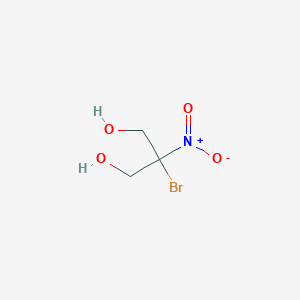| Synonyms |
Click to Show/Hide the Synonyms of This DIG
bronopol; 2-Bromo-2-nitro-1,3-propanediol; 52-51-7; 2-Bromo-2-nitropropane-1,3-diol; Bronosol; Bronocot; 1,3-Propanediol, 2-bromo-2-nitro-; Bronidiol; Bronopolu; Bronotak; Onyxide 500; Lexgard bronopol; 2-Nitro-2-bromo-1,3-propanediol; UNII-6PU1E16C9W; MFCD00007390; beta-Bromo-beta-nitrotrimethyleneglycol; NSC 141021; CHEBI:31306; 6PU1E16C9W; NCGC00164057-01; Bronopolum; 2-Bromo-2-nitro-1,3-propanediol, 98%; DSSTox_CID_4652; 2-Bromo-2-nitropropane-1,3-diol (Bronopol); C3H6BrNO4; DSSTox_RID_77484; DSSTox_GSID_24652; Bronopolu [Polish]; BNPD; Caswell No. 116A; Bioban; Bronopolum [INN-Latin]; Myacide AS plus; Myacide BT; CAS-52-51-7; Bronopol [INN:BAN:JAN]; Myacide Pharma BP; Canguard 409; HSDB 7195; EINECS 200-143-0; UN3241; EPA Pesticide Chemical Code 216400; BRN 1705868; AI3-61639; 2-Bromo-2-nitropropan-1,3-diol; 2-bromo-2-nitro-propane-1,3-diol; Bronopol (JAN/INN); ACMC-1ARSQ; WLN: WNXE1Q1Q; 1, 2-bromo-2-nitro-; EC 200-143-0; SCHEMBL23260; Bioban BNPD-40 (Salt/Mix); CHEMBL1408862; DTXSID8024652; SCHEMBL16556987; LVDKZNITIUWNER-UHFFFAOYSA-; 2-bromo-2nitro-1,3-propanediol; AMY8948; 2-bromo-2-nitro-1,3-propandiol; 2-Bromo-2-nitropropane-1,3-diol [UN3241] [Flammable Solid]; ALBB-031641; HY-B1217; ZINC1088216; Tox21_112079; Tox21_300126; ANW-31486; BDBM50248122; NSC141021; s4553; SBB000393; 2-bromanyl-2-nitro-propane-1,3-diol; AKOS003606838; CCG-213823; CS-4699; DB13960; MCULE-8711651659; NSC-141021; NCGC00164057-02; NCGC00164057-03; NCGC00253984-01; AS-11889; ST041068; .beta.-Bromo-.beta.-nitrotrimethyleneglycol; DB-027831; B1247; Bronopol, PESTANAL(R), analytical standard; FT-0611399; 52B517; C13034; D01577; AB01563195_01; A829125; SR-01000944249; Q-200765; Q2462902; SR-01000944249-1
|
 click to show the detail info of this DBT
click to show the detail info of this DBT
 click to show the detail info of this DBT
click to show the detail info of this DBT
 click to show the detail info of this DBT
click to show the detail info of this DBT
 click to show the detail info of this DBT
click to show the detail info of this DBT

